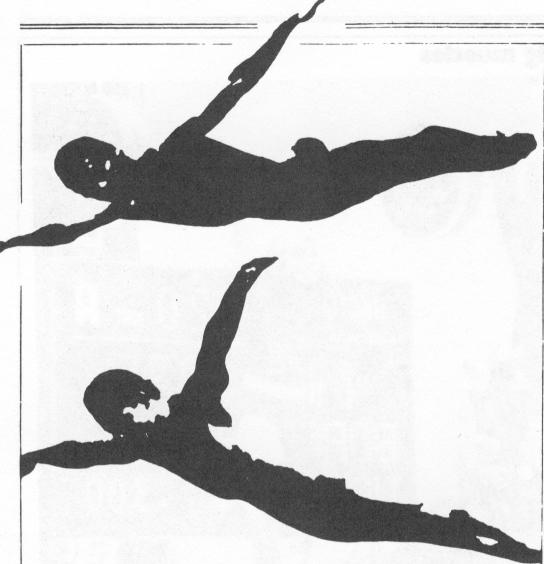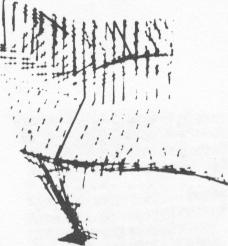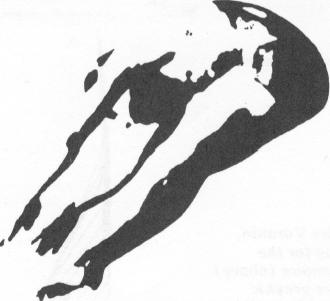| Previous | Index |
![]()
The elasticity of the long distance runner
C B A INC. - PERFORMANCE PROFILE
BILL ROGERS REGULAR MARATHON PACE
The anatomy of a dive
Diving is judged in aesthetic terms as well as in terms of performance. The American, Greg Louganis (above), has a unique technique which allows him to perform better than most divers. Our research revealed that Louganis's method of absorbing kinetic energy from the diving board differs from that of other divers we tested. Louganis employs a coordinated movement in which he first collapses his knees. At the same time he throws his arms downward, directing the force in the board upwards. This is counteracted by the collapsing knees. When his knee joints reach an angle of approximately 90 degrees, he abruptly slows the downward movement of his body. With this movement he loads the diving board with potential energy; that is, he reaches an unlikely position in which his knees are bent (so he is ready to spring) while the board is bent downwards, and ready to spring back. At this point, Louganis accelerates his arms upward, creating an additional downward force which adds to the decelerating force of the body, and increases the loading force on the diving board.
When his arms are approximately horizontal. Louganis begins to slow them down again. At the same instance that his arms begin to decelerate, the diving board starts to unload its potential energy, converting it to kinetic energy. At this point, Louganis prepares for the dive, with the diving board providing the upward force. In other words. from this point onwards Louganis is able to concentrate solely on the diving stunt, without being required to make more effort. Most other divers provide muscular forces throughout the dive-which is less efficient than in Louganis's technique I .
Long distance running is generally considered to be a "cardiovascular event"-one that depends mainly on the athlete's ability to pump blood round his body. Our studies have revealed that biomechanical factors are extremely important, as the demands on the heart and circulation depend on the individual's work output. which in turn depends on the length of his strides and their frequency. Some studies have suggested that running with long strides has the advantage of reducing the number of strides over a given distance. However, our work has indicated that a braking force stops the forward motion of the athlete; the larger the stride, the greater the resulting braking force.
This phenomenon depends on the relationship between the body's centre of gravity and the front foot's point of contact with the ground. We found that if a runner extends the forward leg so that the contact point is ahead of the body's centre of gravity this produces a greater braking force, and makes the running motion less efficient; an athlete's optimum stride is when the braking force is minimum. By calculating the precise relationship between stride and braking force for an individual athlete we can improve his running efficiency by as much as 20 per cent. Leanti*g forward slightly at the hip joint also makes a runner more efficient, as does landing on the ball of the foot rather than on the heel-something that efficient runners often do.
Our measurements of angular displacements at the knee and ankle joints revealed that running involves large amounts of elastic energy. The muscles associated with running contract before the foot hits the track The muscular contraction absorbs kinetic energy which is later released to propel the athlete forwards. This is rather like bouncing a basketball. A properly inflated ball stores the energy put into the bounce, and uses most of this energy in the rebound-that is, elastically. The average runner does not store elastic energy efficiently; he dissipates the energy like a basketball with too little air, which you have to bounce harder, only to find it does not go as high. The better runner is the one who can absorb more elastic kinetic energy, in analogy to bouncing an over-inflated basketball.
So the average runner requires more energy in each step, compared with the elite athlete who retains elastic energy. Future research should show whether an athlete can acquire or increase elastic energy through training. C
8
0
With data from NASA on the location of the centres of gravity of body segments. the program can also calculate the displacement, velocity and acceleration of these centres of gravity. and can again "fit" the movement smoothly with computed curves. We then pass this information on to the coaches and athletes. For example, we can investigate what happens if small adjustments are made to certain parts of an athlete's movement, by studying the effects on the stick figures The boxes describe some of our results in a selection of four athletic events, and show how we can learn to Improve techniques through making the best use of the bode as a ph>sical system. 0
NEW SCIENTIST July 1980



![]()
| Previous | Index |